Views of Tenant Farmers and Agricultural Landlords on Aspects of the Agricultural Tenancy System
Results from surveys of tenant farmers and agricultural landlords on aspects of the tenancy system such as rent review, fixed equipment, diversification and tenancy relationships.
6 DISPUTES AND WAYGO
Summary
1. Only a minority of tenant farmers and landlords had experienced a major dispute with their landlord/tenant. However, tenant farmers who had diversified their business were more likely to have had experience of a dispute than those who had not diversified.
2. Of those tenant farmers and landlords who had had a major dispute with their landlord/tenant, they were most likely to seek to resolve the dispute either by talking to the landlord/tenant directly, or by seeking advice from a professional who could help.
3. Only small numbers of tenant farmers and landlords had experienced waygo on a previous tenancy. Of those who had gone through the process, overall, both tenant farmers and landlords said that the process was easy and were satisfied with the outcome.
6.1 This section of the report looks at tenant farmers' and landlords' experience of disputes and how these were resolved, and on issues around waygo.
Disputes
6.2 Tenant farmers and landlords who rent-out on leases of at least a year were asked if they had been in a major dispute with a current or previous Overall, only 27% of tenant farmers had experienced a major dispute with a landlord over any issue, while 38% of landlords who answered any of the questions on disputes reported having had a major dispute with a tenant over any issue (Table 6.1).
6.3 The most commonly-reported sources of dispute concerned:
- Rent reviews (experienced by 15% of tenant farmers and 20% of landlords)
- Fixed equipment (experienced by 9% of tenant farmers and 16% of landlords)
- Conflicts with other business interest (experienced by 8% of tenant farmers and 15% of landlords).
Table 6.1: Views on the source of major disputes experienced by tenant farmers and landlords
| Tenant farmers | Landlords | |||
|---|---|---|---|---|
| Q. Have you had any major disputes with a current or previous landlord on the following issues? |
Q. Have you had any major disputes with any current or previous tenants on the following issues? |
|||
| Yes | No | Yes | No | |
| % | % | % | % | |
| Any dispute | 27 | 73 | 38 | 62 |
| Rent review | 15 | 85 | 20 | 78 |
| Fixed equipment | 9 | 91 | 16 | 82 |
| Conflicts with other business interests (including sporting) |
8 | 92 | 15 | 84 |
| Diversification | 5 | 95 | 3 | 95 |
| Other type of major dispute | 4 | 96 | 12 | 84 |
| Issues around assignation | 4 | 95 | 7 | 91 |
| Lease issues | 2 | 98 | n/a | n/a |
| Conflicts with landlord's interests | 1 | 99 | n/a | n/a |
| Non-payment of rents | 1 | 99 | 14 | 84 |
| Base | 1,002 | 274; 269; 262; 263; 258; 214; 261; n/a; n/a; 264 | ||
6.4 There appears to be a relationship among tenant farmers between experience of a major dispute and their perception of their relationship with their landlord, and rating of satisfaction with their tenancy (Table 6.2).
6.5 As the table shows, tenant farmers who believe that they have a poor relationship with their landlord or are dissatisfied with their tenancy are more likely to have experienced a major dispute on each of the issues in question.
Table 6.2: Tenant farmers' experience of major disputes and relationship with landlord and satisfaction with tenancy[19]
Q. Have you had any major disputes with a current or previous landlord on the following issues?
| Base: 1,002 | Overall | Relationship with landlord |
Satisfaction with tenancy |
||
|---|---|---|---|---|---|
| Good | Poor | Satisfied | Dissatisfied | ||
| % | % | % | % | % | |
| Rent review | 15 | 11 | 40 | 11 | 38 |
| Fixed equipment | 9 | 5 | 30 | 5 | 33 |
| Conflicts with other business interests |
8 | 5 | 27 | 5 | 24 |
| Diversification | 5 | 3 | 19 | 3 | 18 |
| Other type of dispute | 4 | 2 | 17 | 3 | 11 |
| Issues around assignation | 4 | 2 | 14 | 2 | 15 |
| Lease issues | 2 | 1 | 7 | * | 8 |
| Conflicts with landlord's interests |
1 | * | 4 | 1 | 3 |
| Non-payment of rents | 1 | * | 3 | * | 4 |
6.6 Tenant farmers with a Secure 1991 Act tenancy were more likely to have had a major dispute with a landlord over rent reviews (19%) or diversification (7%) than those with an LDT/SLDT (9% and 1% respectively) (Table 6.3).
Table 6.3: Tenant farmers' experience of major disputes by tenancy type
Q. Have you had any major disputes with a current or previous landlord on the following issues?
| Overall | Secure 1991 Act Tenancy |
LDT/SLDT | |
|---|---|---|---|
| % | % | % | |
| Rent review | 15 | 19 | 9 |
| Diversification | 5 | 7 | 1 |
| Base: | 1,002 | 593 | 187 |
6.7 Major disputes with landlords were slightly more common among tenant farmers who had diversified their farm business, as shown in Table 6.4.
Table 6.4: Experience of major disputes with a landlord and diversification
Q. Have you had any major disputes with a current or previous landlord on the following issues?
| Overall | Have diversified? | ||
|---|---|---|---|
| Yes | No | ||
| % | % | % | |
| Rent review | 15 | 23 | 12 |
| Fixed equipment | 9 | 16 | 6 |
| Conflicts with other business interests (including sporting) | 8 | 13 | 6 |
| Other type of dispute | 8 | 10 | 6 |
| Diversification | 5 | 10 | 3 |
| Issues around assignation | 4 | 8 | 3 |
| Non-payment of rents | 1 | 2 | * |
| Base: | 1,002 | 302 | 701 |
6.8 Those tenant farmers and landlords who had experienced a major dispute on any of the issues in question were then asked about the methods used to resolve such disputes, and their views of these methods.
6.9 As shown in Table 6.5 below, tenant farmers were most likely to have talked to a professional adviser to help them find a solution to a dispute, with three-quarters (74%) reporting having done this. Two-thirds (65%) talked on their own to the landlord to find a solution. Smaller proportions used formal mediation (29%) or a formal arbitration process (17%).
Table 6.5: Methods used to resolve disputes
Q. Did you use any of the following to resolve your dispute?
| Tenant farmers | Landlords | |||
|---|---|---|---|---|
| Yes | No | Yes | No | |
| % | % | % | % | |
| Talking to a professional adviser | 74 | 26 | 79 | 21 |
| Talking with the landlord/tenant | 65 | 34 | 84 | 16 |
| Formal mediation | 29 | 70 | 11 | 89 |
| Formal arbitration process | 17 | 81 | 27 | 72 |
| Base | 280 | 87; 71; 83; 83 | ||
6.10 A broadly similar pattern was found among landlords, where 84% said that they had spoken to the tenant on their own to find a solution to a dispute with a tenant, while 79% had talked to a professional adviser. A quarter (27%) used a formal arbitration process and 11% used formal mediation to resolve a dispute.
6.11 There were some differences in terms of tenant farmers' likelihood to have used the following dispute resolution measures, by type of lease held:
- Those with an LDT/SLDT (83%) were more likely than those with a Secure 1991 Act tenancy (61%) to have talked on their own to the landlord to find a solution
- Respondents with a Secure 1991 Act tenancy (80%) were more likely than those with an LDT/SLDT (63%) to have talked to a professional adviser
- Those with a Secure 1991 Act tenancy (31%) were more likely than those with an 'other' type of tenancy arrangement (13%) to have used formal mediation.
6.12 Respondents were asked a series of questions over use of the Land Court to resolve disputes. Around one in ten (11%) tenant farmers reported having submitted a case to the Land Court and proceeded, with a further 8% having submitted but not proceeded. The majority of tenant farmers (81%) had not used the Land Court (Figure 6.1).
6.13 Two-thirds (66%) of those landlords who gave an answer said that they had never used the Land Court, while 22% had submitted to the Court and proceeded, and 11% had submitted and not proceeded.
Figure 6.1: Use of the Land Court to resolve disputes
Tenant farmers Q. Did you use the Land Court to resolve your dispute?
Landlords Q. Have you ever used the Land Court to resolve a dispute?
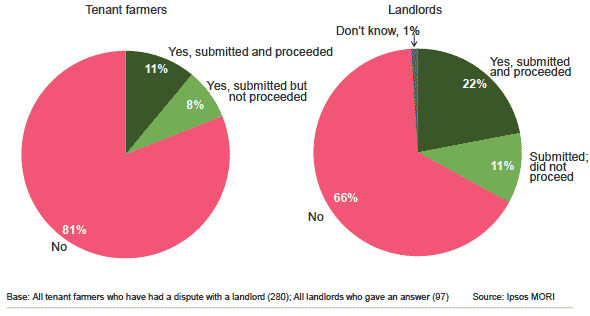
6.14 Those who did not use the Land Court to resolve dispute were asked if they considered using it. Among tenant farmers, 29% said that they did consider using the Land Court while 71% said that they did not. Forty-three per cent of landlords had considered using the Land Court, while 55% had not.
6.15 Tenant farmers and landlords were asked about a number of potential reasons for not considering submitting to the Land Court (Figure 6.2). The most common reasons:
- The statement 'Didn't need to - could resolve (the dispute) in other ways' was agreed with by 63% of landlords and 41% of tenant farmers
- The statement 'Legal costs too high' was agreed with by 41% of landlords and 43% of tenants
- The statement 'Didn't think it was a major enough dispute' was agreed with by 36% of landlords and 12% of tenants.
Figure 6.2: Reasons given for not considering using the Land Court
Q. Why did you not consider submitting to the Land Court?
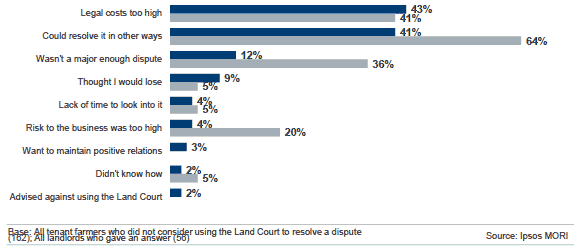
6.16 Respondents were asked how likely or unlikely it would be for them to use formal mediation services in the event of a major dispute in the future. More than half (56%) of tenant farmers said that they were unlikely (26% not at all likely) to use such formal mediation services in the future. However, 39% of tenant farmers said that they would be likely to use such services in the event of a future major dispute. This compares with just over half of landlords (54%) who said that they would be likely to use formal mediation services in the future, and one-third (35%) who would be unlikely (Figure 6.3).
Figure 6.3: Likelihood to use formal mediation services in the future
Q. How likely or unlikely would you be to use formal mediation services in the future should you have a major dispute with your landlord/a tenant?
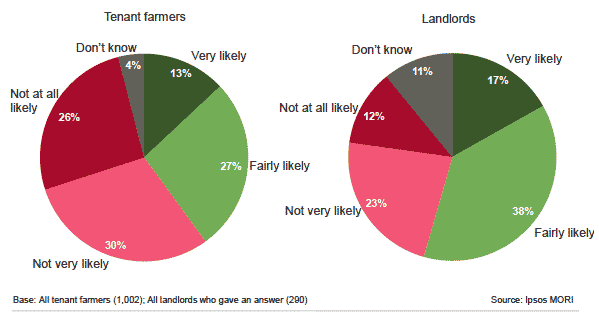
Waygo
6.17 Overall, only 4% of tenant farmers and 37% of landlords said that they have experience of waygo from a previous tenancy, while 94% and 58% respectively had no such experience.
6.18 Of those 46 tenant farmers who have experience of waygo, 33 reported that there had been an independent valuation conducted as part of the process, while 9 said that this had not been the case. More than three-quarters (78%) of landlords said that there was an independent valuation, and 17% that there had not been one.
6.19 Of the 35 tenant farmers who had had an independent valuation, 27 said that they agreed with the valuation, while 26 said that their landlord agreed with it. Five of these tenant farmers said that they did not agree with the valuation, and fewer than 5 reported that their landlord did not agree (Table 6.5).
6.20 Among landlords, 79% said that they agreed with their valuation (20% did not), and 75% said that their tenant agreed with the valuation (19% said that their tenant did not agree).
Table 6.6: Agreement and disagreement with independent valuation at waygo[20]
| Yes | No | Don't know | Base | |
|---|---|---|---|---|
| Did you (tenant) agree with the valuation? | 27 | 5 | 2 | 35 |
| Did your landlord agree with the valuation? | 26 | 2 | 6 | 35 |
| Did you (landlord) agree with the valuation? | 79% | 20% | 1% | 84 |
| Did your tenant agree with the valuation? | 75% | 19% | 6% | 81 |
6.21 Of the 46 tenant farmers who have experienced waygo, 42 reported that the situation was now resolved. This compares with 98% of landlords who reported that waygo is now resolved.
6.22 Twenty-six of the 46 tenant farmers said that they would rate their experience of waygo as easy, while 15 rated it as difficult. This compares with 65% of landlords who found the process easy (19% very easy) and 35% who said it was difficult (Figure 6.4).
Figure 6.4: Ease or difficulty of the waygo process[21]
Q. How easy or difficult would you rate your experience of waygo
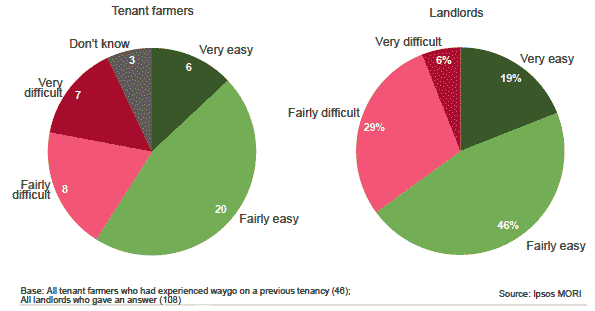
6.23 Thirty-two of those 44 tenant farmers who had gone through the process said that they were satisfied with the outcome, including 14 who reported being very satisfied. Seven said that they were dissatisfied, while fewer than 5 were neither satisfied nor dissatisfied. This compares with 69% of landlords who were satisfied (27% were very satisfied) and 13% who were dissatisfied, while 17% were neither satisfied nor dissatisfied (Figure 6.5).
Figure 6.5: Satisfaction with the outcome of waygo[22]
Q. How satisfied or dissatisfied were you with the outcome?
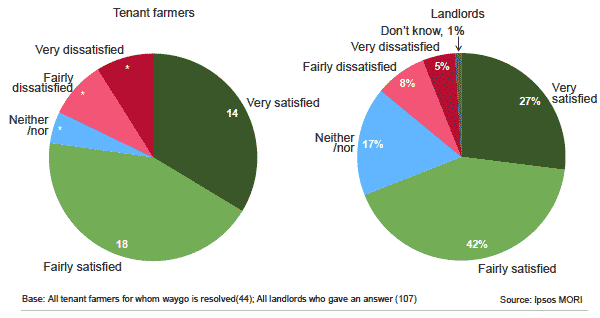
Contact
Email: Liz Hawkins
There is a problem
Thanks for your feedback